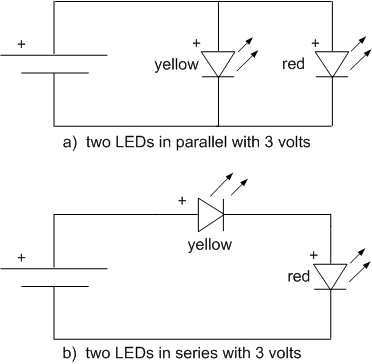Force and motion
Force and Motion
Series and Parallel Circuits
One battery – two LEDs
The video above and diagrams below show two LEDs – one red and one yellow – connected to a coin battery in two different ways. In the **parallel **connection, each LED has a direct connection to the battery, so both see the full battery voltage of 3 volts, and both come on. In the **series **configuration, one LED is connected to the (+) side of the battery and to the other LED, which is then attached to the (-) side of the battery. Neither LED turns on, because the voltage of the battery gets didvided up between them, and neither one sees enough voltage to turn on.

Two betteries – two LEDs
In Lesson 1, students learned that a single coin battery will not always light up two LEDs in parallel. It depends on their colors. Two LEDs of the same color will turn on together, as will red and yellow or green and blue; but either blue or green will be turned off when red or yellow is connected in parallel. Is there a way around this? Is there a way to put either red or yellow in the same circuit with blue or green, power both from the same battery and control both from the same switch?
The video above and digarms below show how to use two coin batteries to turn on two LEDs simultaneously, regardless of the colors. The two batteries have to be connected in series – (+) side of the first to (-) side of the second, so their voltages will add up to 6 volts. If the LEDs are connected in parallel, they will both come on, but the blue or green LED may not be as bright as the red or yellow one. If they are connected in series, both LEDs will reach full brightness.The second set of diagrams below show how to add a switch to each circuit, so it controls both LEDs

Switches added to control both LEDs
